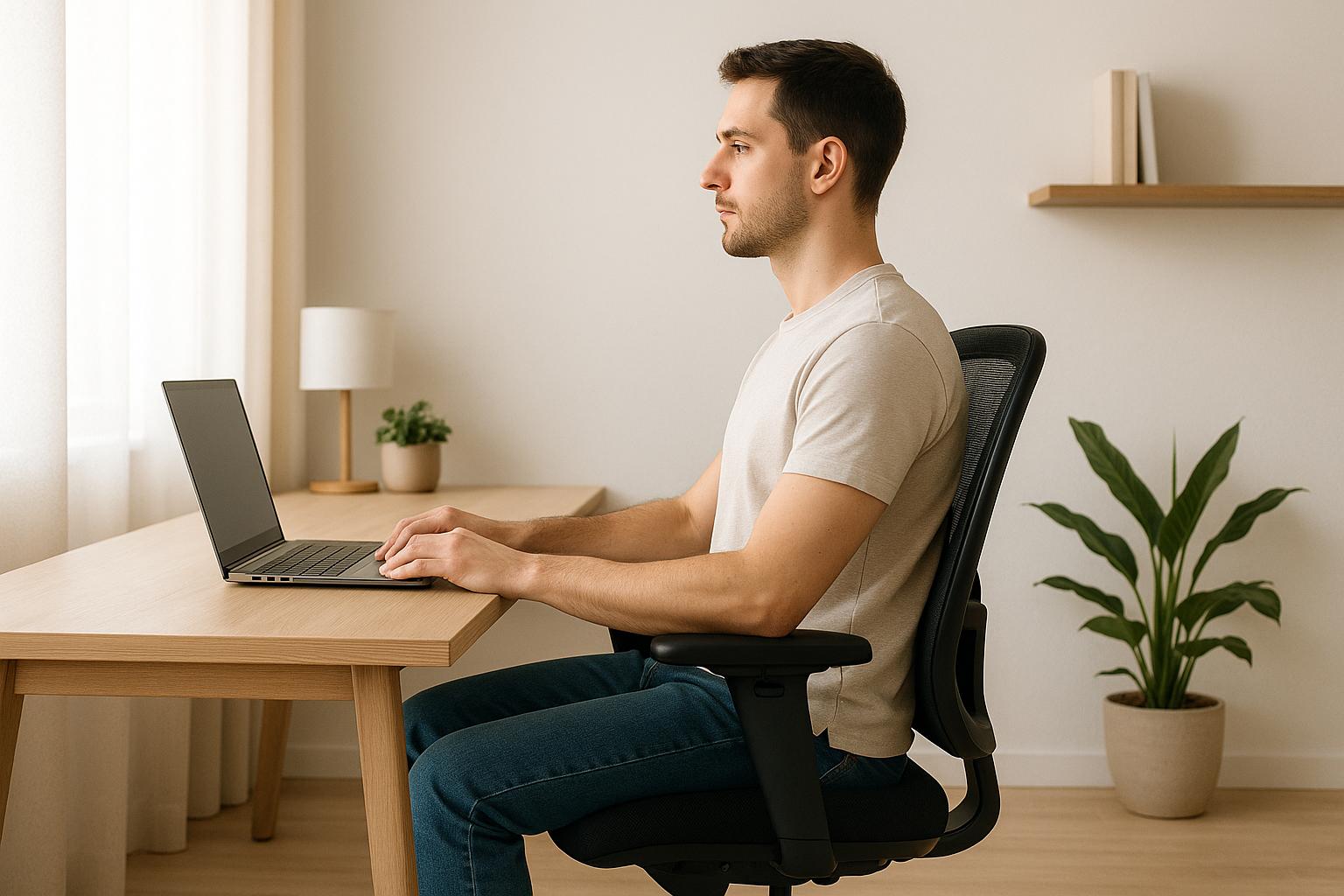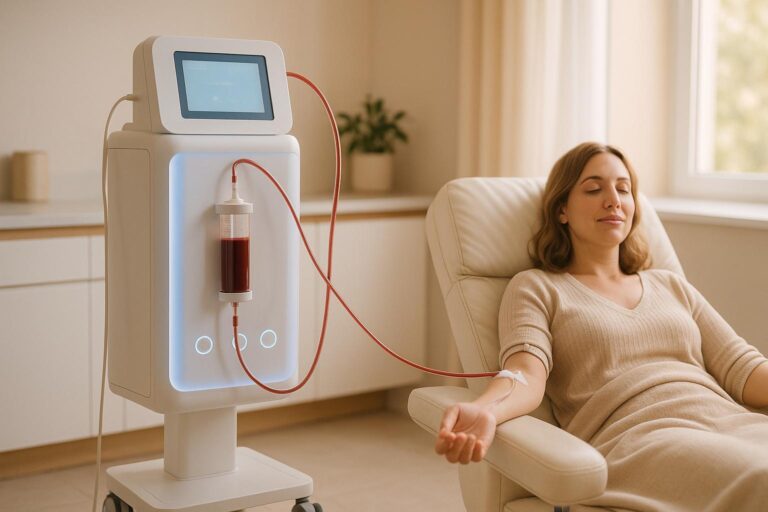Did you know poor posture can add up to 60 pounds of strain on your spine? Fixing your posture is easier than you think. Here’s how you can start today:
- Check your posture: Use a mirror or the wall test to spot misalignments.
- Strengthen key muscles: Exercises like planks, bird dog, and glute bridges can improve spinal support.
- Improve your workspace: Adjust your chair, desk, and monitor for better ergonomics.
- Consider chiropractic care: The Gonstead method offers precise spinal corrections for lasting results.
- Stay active: Take stretch breaks every 20–30 minutes to counteract long sitting hours.
Quick Comparison of Posture Correction Methods
| Method | Best For | Limitations |
|---|---|---|
| Gonstead Chiropractic | Chronic pain, spinal misalignments | Requires specialized care and regular visits |
| Home Exercises | Mild posture issues | Needs consistency, may not fix severe issues |
| Posture Devices | Raising awareness | Limited long-term effectiveness |
| Ergonomic Adjustments | Workplace posture improvement | Doesn’t address underlying physical issues |
| Physical Therapy | Rehabilitation, muscle strength | Time-intensive, may depend on insurance |
Start small – check your posture, add a few stretches, and adjust your workspace. Over time, these habits can transform your spinal health and overall well-being.
Straighten Up: 12 Exercises to Align Your Posture Perfectly
Gonstead Chiropractic Principles Explained
The Gonstead method offers a highly targeted approach to addressing spinal issues and improving posture through precise adjustment techniques. Developed by Dr. Clarence S. Gonstead in 1923, this chiropractic method focuses on diagnosing and correcting vertebral subluxations. Unlike general chiropractic techniques, the Gonstead approach zeroes in on specific spinal segments, aiming for accuracy and long-term results. This level of precision aligns with the goal of restoring proper spinal alignment for lasting posture improvement.
"The principles of the Gonstead Method are the simple principles of chiropractic put to work; how to understand what causes nerve pressure, how to find it on the patient, how to achieve a corrective setting of the offending vertebra, and how to know when the chiropractor’s job is done, and nature’s begins." – Dr. Clarence Gonstead
This method emphasizes the body’s structural foundation, particularly the intervertebral discs, aiming to achieve balance by aligning the pelvis, vertebrae, and legs. By addressing the root causes of postural issues, it goes beyond merely treating surface-level symptoms.
How the Gonstead Method Works
The Gonstead Technique relies on five essential components – Visualization, Instrumentation, Palpation, X-Ray Analysis, and Symptom Assessment – to identify and treat spinal problems. Practitioners carefully observe posture, gait, and spinal alignment to detect imbalances. Tools like the Nervoscope and Temperature Meter help pinpoint areas of nerve interference. Hands-on palpation is used to assess muscle tension and joint restrictions, while Full Spine Radiographs provide a detailed view of the spinal structure. Finally, symptom assessment evaluates how these spinal issues affect overall health and daily life.
Dr. Gonstead’s commitment to this method is reflected in his remarkable history, with over 1.2 million office visits and workdays that stretched up to 23 hours. Today, the Gonstead System is used by 58.5% of chiropractors, showcasing its widespread adoption and reputation for precision.
How Gonstead Adjustments Fix Posture
Gonstead adjustments are specifically designed to target intervertebral discs, restoring proper spinal alignment and motion. Instead of attempting to adjust the entire spine in one session, this technique focuses on specific problem areas to achieve better balance and functionality.
The method addresses vertebral subluxations – misalignments that disrupt nervous system function. By correcting these subluxations, chiropractors can enhance nerve communication, improve muscle balance, and promote healthier disc function. These improvements collectively help the body maintain proper posture.
Practitioners trained in the Gonstead method use specialized equipment like the Hydraulic Hi-Lo Table, Knee-Chest Table, and Cervical Chair to ensure precise positioning during adjustments. Unlike techniques that involve twisting the spine, the Gonstead method uses controlled and deliberate movements. For example, neck adjustments are often performed while the patient is seated to maximize precision.
"The Gonstead system works. It’s the most complete biomechanical analysis discipline available to chiropractors today." – Herald Square Chiropractic and Sport
The benefits of Gonstead adjustments for posture improvement include a more balanced stance, reduced discomfort in the back, neck, and joints, greater flexibility in daily activities, and improved communication within the nervous system. These effects work together to create better spinal alignment and a healthier, more upright posture.
Practical Steps to Fix Your Posture
Building on Gonstead’s approach to targeted spinal corrections, these actionable tips can help you maintain better posture in your daily routine. By identifying weak areas, strengthening key muscles, and improving your environment, you can take meaningful steps toward better alignment and comfort.
How to Check Your Posture
A quick daily check-in with your posture can go a long way. Use a full-length mirror to assess your alignment. Stand barefoot and see if your ears, shoulders, hips, knees, and ankles form a straight vertical line. Another helpful method is the wall test: stand with your head, shoulder blades, and buttocks against a wall. This can reveal any misalignments. Also, pay attention to how your head moves when you rotate it or how your mid and lower back feel during mobility checks – any restrictions could signal areas to work on.
"Good posture means that your body is in proper alignment with minimal stress on your muscles and joints."
Once you’ve identified any misalignments, incorporate exercises tailored to improving those areas.
Exercises to Improve Spinal Alignment
Strengthening your core and back is key to better posture. Here are some exercises that can help improve both mobility and stability:
- Cat-Cow stretches: These ease tension in your torso, shoulders, and neck while improving spinal mobility. Start on your hands and knees, arch your back (cow), then round it toward the ceiling (cat). This is especially helpful for counteracting long hours of sitting.
- Child’s Pose: A gentle stretch for your spine, glutes, and hamstrings. From a kneeling position, sit back onto your heels and extend your arms forward on the floor.
- Planks and side planks: These strengthen your core and back muscles. Start with 30-second holds and gradually increase as you build strength. Side planks also target the muscles along your sides and glutes, providing extra support for your spine.
- Bird Dog: This stabilizes your core and lower back. From a hands-and-knees position, extend one arm and the opposite leg, hold briefly, then switch sides.
- Glute bridges: These activate your glutes and help relieve lower back pain. Lie on your back with knees bent, lift your hips, and squeeze your glutes at the top.
- Thoracic spine rotations: Great for relieving tightness and improving mid-back mobility. Rotate your upper body left and right while seated or standing, focusing on your mid-spine.
- Cobra Pose: This strengthens your upper back and helps release spinal tension. Lie face down, press your palms into the floor, and lift your chest while keeping your hips grounded.
"If you imagine a straight line coming down from the ceiling, it should hit you in your ear lobe, the tip of your shoulder and the side of your pelvis. If you’re standing, it also should go through your knee and the outside part of your ankle. And if anything deviates from that straight line, that’s where extra forces or pressures are being placed on your body." – Jennifer Danzo, DPT
Posture Tools and Better Ergonomics
Improving your workspace can make a noticeable difference in your posture. Even small changes can reduce strain and promote better spinal health.
- Chair adjustments: Choose a chair that supports your spine’s natural "S" curve. If buying a new chair isn’t feasible, a lumbar support pillow can make a basic chair more posture-friendly. For example, the Steelcase Gesture office chair ($1,481) offers advanced adjustability, while affordable lumbar cushions provide a budget-friendly alternative.
- Standing desks: Alternating between sitting and standing can reduce stiffness. The Uplift V2 Standing Desk, starting at $599, is a customizable option for creating a more dynamic workstation.
- Monitor height: Position your screen so the top edge is at or just below eye level, about an arm’s length away. The Rain Design iLevel2 laptop stand is a sturdy option for achieving the right height.
- Keyboard and mouse placement: Keep them close to maintain a relaxed shoulder and neck position. Compact keyboards without number pads, like the Kinesis Freestyle Edge RGB, and ergonomic mice, such as the Logitech M720 Triathlon, are great choices.
- Lighting: Proper lighting reduces eye strain and helps prevent forward head posture. Combine natural light with task lighting, like the IKEA Forså Work Lamp, for an affordable solution.
"Neutral posture prevents back pain."
Even with the best ergonomic setup, regular movement is essential. Take 1–2 minute stretch breaks every 20–30 minutes and longer breaks every hour. This is especially important given that sedentary jobs have increased by 83% since 1950, with the average office worker sitting for about 15 hours a day.
Posture correctors can also help, but use them sparingly. Dr. Christina Markar, a board-certified chiropractor, advises:
"You don’t want to be wearing one 24/7 and become dependent on it. Rather, you want one that trains your body to truly correct the issues, so you become independent from it."
The ComfyBrace Adjustable Posture Corrector offers breathable support for extended wear, but experts like Jennifer Danzo, DPT, caution against relying too heavily on passive devices:
"I discourage people from using passive devices, like harnesses. As soon as you take them off you’re not going to get any benefit from them."
Lastly, proper desk posture matters. Align your head with your shoulders, relax your shoulders, sit back with lower back support, keep your hips even, and ensure your feet are flat on the floor or on a footrest. Research shows that 41% of remote workers experience lower back pain, while 24% report neck pain. Small ergonomic tweaks can make a big difference in your comfort and spinal health over time.
sbb-itb-d9e542d
Kinnection Clinic‘s Posture Treatment Approach

At Kinnection Clinic, the focus goes beyond surface-level fixes for poor posture. By combining precise Gonstead chiropractic adjustments with a thorough wellness program, the clinic tackles the deeper causes of misalignment.
Custom Posture Evaluation and Treatment
Kinnection Clinic employs the Gonstead Chiropractic System, a specialized technique designed to restore spinal alignment with pinpoint accuracy. Using a detailed 5-step evaluation, the clinic identifies the root causes of spinal misalignments:
- Observation: Dr. Lars Gunnar evaluates posture, gait, and spinal curves to detect misalignments.
- Instrumentation: The Nervoscope identifies areas of inflammation and nerve pressure along the spine.
- Static Palpation: This step checks for muscle tension and irregular spinal positioning.
- Motion Palpation: Each vertebra’s mobility is tested to assess spinal motion.
- X-ray Analysis: Digital X-rays reveal the exact location and severity of spinal misalignments.
"To see is to know; to not see is to guess." – Dr. Clarence Gonstead
Kinnection Clinic’s use of digital X-rays, thermographic scans, and biomechanical assessments ensures that every spinal issue is precisely identified. This level of accuracy is noteworthy, as only about 500 doctors worldwide specialize in the Gonstead Chiropractic method. Each treatment plan is meticulously customized to fit your unique spinal needs.
This detailed evaluation forms the foundation for a personalized treatment plan that addresses not just your posture but your overall health.
Complete Wellness Support
Kinnection Clinic recognizes that spinal health is influenced by more than just alignment. Factors like muscle imbalances, poor nutrition, stress, and daily habits all play a role. That’s why their approach includes a wide range of wellness strategies.
The clinic combines Gonstead chiropractic care with functional medicine, regenerative therapies, and performance coaching. Your posture correction plan may include:
- Nutrition and Supplements: Tailored recommendations to address deficiencies and support spinal health.
- Lifestyle Adjustments: Strategies to improve habits that impact posture.
- Functional Medicine Consultation: Advanced lab testing to uncover inflammation, nutrient gaps, or hormonal imbalances.
- Targeted Therapies: Options like IV treatments, PRP (Platelet-Rich Plasma), and peptide therapy to enhance recovery and strengthen spinal support.
Kinnection Clinic also provides specialized care for individuals at every life stage, including infants, children, and pregnant women. This family-centered perspective emphasizes the importance of building good posture habits early and supporting them throughout life.
"Kinnection Clinic truly fixes the root cause, not just symptoms, with personalized care that delivers real, lasting relief." – Robert B.
To ensure long-term success, the clinic also offers Performance Coaching and Mindset Training. These programs teach movement techniques, stress management, and how everyday activities impact spinal health. By focusing on prevention and sustainable habits, Kinnection Clinic empowers you to maintain better posture and spinal health as you age.
This comprehensive approach means you’re not just receiving adjustments – you’re getting a complete plan that integrates nutrition, movement, stress management, and targeted therapies to support your overall well-being.
Posture Correction Methods Compared
Understanding the various methods for posture correction can help you make better choices for your spinal health. Each technique comes with its own benefits and challenges, and selecting the right one depends on your specific needs. Here’s a breakdown of common posture correction methods:
Posture Correction Methods Comparison Table
| Method | Effectiveness | Best For | Limitations |
|---|---|---|---|
| Gonstead Chiropractic | High – targets specific spinal issues | Chronic pain and precise spinal misalignments | Requires specialized care and ongoing visits |
| General Chiropractic | Moderate to High – broader techniques | General posture maintenance | Less precise compared to the Gonstead method |
| Home Exercises & Stretching | Moderate – helps with mild issues | Forward head posture and minor imbalances | Demands consistency and may not address severe conditions |
| Posture Correction Devices | Low to Moderate – offers real-time feedback | Raising posture awareness | Long-term effectiveness is still under study |
| Ergonomic Adjustments | Moderate – prevents poor posture | Workplace posture improvement | Focuses on environment, not underlying physical issues |
| Physical Therapy | Moderate to High – combines exercise and therapy | Rehabilitation and muscle strengthening | Requires time, commitment, and may depend on insurance coverage |
The table provides a quick snapshot of each method. Below, let’s explore their strengths and limitations in more detail.
The Gonstead Chiropractic method is known for its precision. It uses a structured, systematic approach to address spinal biomechanics through five diagnostic techniques that pinpoint subluxations. This makes it particularly effective for chronic pain and structural misalignments.
For those with milder concerns, home exercises and stretching can be a practical solution. Targeted exercises help correct forward head posture, which significantly increases strain on the cervical spine – from about 10–12 pounds in a neutral position to 49 pounds when the head is hunched forward. However, severe cases often require professional intervention.
Research has shown that pairing manual therapy with stabilization exercises can yield better results for managing neck pain and improving posture than exercises alone. This highlights the value of combining therapies for more comprehensive care.
Posture correction devices provide immediate feedback, helping users become more aware of their posture. However, they don’t address structural issues like spinal misalignments and require further validation for their long-term effectiveness.
Chiropractic care offers a cost-effective solution for many. Typical sessions range from $65 to $95, making it more affordable than surgical options or prolonged reliance on medications for chronic pain. Moreover, Spinal Manipulative Therapy (SMT) has demonstrated effectiveness comparable to physical therapy or standard medical care for managing spine-related pain.
Different methods suit different conditions. For example, forward head posture benefits greatly from corrective exercises and manual therapy, while structural issues like scoliosis often require the precision of methods such as Gonstead Chiropractic.
It’s essential to note that improvement timelines can vary. While wearable devices may provide instant feedback, noticeable improvements from chiropractic adjustments or exercise routines may take weeks. Combining multiple approaches – like chiropractic care, exercises, and ergonomic adjustments – can often deliver the best results by addressing both structural problems and daily habits.
Ultimately, the best method depends on your specific condition, budget, and willingness to commit to a routine. Mild posture concerns might improve with exercises and ergonomic changes, but chronic pain or serious misalignments usually call for specialized chiropractic care.
Key Points for Better Posture
Improving posture isn’t just about occasional adjustments – it’s about creating daily habits and staying mindful of your movements. A solid plan combines strengthening exercises, ergonomic awareness, and intentional positioning throughout your day.
Start with the basics: keep your shoulders back, chest open, and head aligned whether you’re sitting, standing, or moving. When seated, ensure your back is straight, shoulders relaxed, and feet flat on the floor. When standing, distribute your weight evenly across both feet .
"Maintaining good posture throughout the day is one of the simplest yet most effective ways to protect your spine."
– KB Chiropractic
Strengthening your core is also a game-changer. Regular core and flexibility exercises not only build strength but also reduce stiffness, making it easier to maintain proper posture.
Another key factor? Managing screen time wisely. Take short breaks every 30–40 minutes to stand, stretch, and reset your posture. Adjust your workstation by raising your screen to eye level and using an ergonomic chair. These small changes can make a big difference – especially since tilting your head forward by just 30 degrees can more than triple the strain on your neck .
Don’t overlook the importance of sleep. A supportive mattress and pillow can do wonders for your spine. Sleeping on your back or side with proper leg support helps maintain alignment overnight.
Lifestyle choices also play a role in posture health. Staying hydrated, keeping a healthy weight, and wearing supportive footwear all contribute to reducing strain on your spine .
Physical therapist Astrid DiVincent, PT, DPT, OCS, highlights the importance of movement throughout the day:
"No posture is good for too long a period of time. You may have the best ergonomic situation possible, but if you sit at your desk for 10 hours a day, you’re going to have pain."
Be mindful of warning signs that may require professional attention. Persistent back or neck pain, unexplained weakness or numbness in your arms or legs, or limited mobility should not be ignored. Visible issues like uneven shoulders or a noticeable spinal curve are also reasons to seek evaluation .
Consistency is key to success. Check your posture every 15 minutes or so, making small adjustments as needed. Back pain is the second most common reason people visit their primary care providers, so integrating these practices into your daily routine can help prevent serious issues. With regular effort and awareness, you’ll not only improve your posture but also support your overall well-being.
FAQs
How can I check if my posture is straining my spine, and what simple tests can I try at home?
If you’re wondering whether your posture might be putting unnecessary strain on your spine, there are a couple of easy tests you can try at home. Start by standing with your back against a wall. Ideally, your shoulders and buttocks should touch the wall while maintaining the natural curve of your lower back. Then, check the space between your neck and the wall. If the gap feels unusually large or small, it might be a sign that your posture needs attention.
Pay attention to other indicators, too. Persistent back or neck pain, muscle fatigue, or stiffness could all point to posture-related issues. Visually, an exaggerated inward or outward curve in your spine might also signal a problem. If any of these signs resonate, it’s worth adding posture-focused exercises or making ergonomic tweaks to your daily habits. These changes can help improve alignment and ease discomfort.
What are the best exercises to improve spinal alignment and posture?
To support better spinal alignment and improve posture, focus on exercises that target your core and back muscles. Here are a few highly effective options to consider:
- Planks: These build core strength, which plays a crucial role in keeping your posture upright and stable.
- Bridges: Great for strengthening your lower back and glutes, helping to stabilize your spine.
- Back extensions: These exercises work the muscles along your spine, promoting better alignment and support.
Adding gentle yoga poses and stretching routines to your routine can also boost flexibility and ease muscle tension, both of which contribute to maintaining good posture. Remember, consistency matters – stick with these exercises regularly to see meaningful improvements in your spinal health and overall comfort.
What makes the Gonstead Chiropractic method unique in improving posture compared to general chiropractic techniques?
The Gonstead Chiropractic method takes a detailed and focused approach to addressing posture problems. Unlike broader chiropractic techniques, it zeroes in on precise, manual adjustments designed to correct specific spinal misalignments rather than using generalized manipulations.
This technique emphasizes both accuracy and safety, working to realign the spine properly and improve posture in a targeted way. By addressing the underlying causes of misalignments, it not only relieves discomfort but also promotes lasting spinal health.



